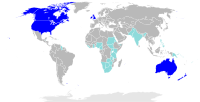Population

With over 51 million inhabitants, England is the most populous country of the United Kingdom, accounting for 84% of the combined total.[130] England taken as a unit and measured against international states has the fourth largest population in the European Union and would be the 25th largest country by population in the world.[131] With a density of 395 people per square kilometre, it would be the second most densely populated country in the European Union after Malta. The English people are a British people[3]—genetic evidence suggests that 75–95% descend in the paternal line from prehistoric settlers who originally came from the Iberian Peninsula. There is a significant Norse element, as well as a 5% contribution from Angles and Saxons, though other geneticists place the Norse-Germanic estimate up to half. Over time various cultures have been influential—Prehistoric, Brythonic,[139] Roman, Anglo-Saxon,[140] Norse Viking,[141] Gaelic cultures, as well as a large influence from Normans. There is an English diaspora in former parts of the British Empire; especially the United States, Canada, Australia, Chile, South Africa and New Zealand. Since the late 1990s, English people have migrated to Spain

At the time of the Domesday Book, compiled in 1086, more than 90% of the English population of about two million lived in the countryside. By 1801 the population had grown to 8.3 million, and by 1901 had grown to 30.5 million. Due to the economic prosperity in South East England there are many economic migrants from the other parts of the United Kingdom.[3] There has been significant Irish migration, with 25% of English people having Irish ancestry. The European population totals at 89.90%, including Germans andOther people from much further afield in the former British colonies have arrived since the 1950s—5.30% of people living in England have migrated from the Indian subcontinent, mostly India and Pakistan. 2.30% of the population are black, mostly from the Caribbean.[3][150] There is a significant number of Chinese and British Chinese. As of 2007, 22% of primary school children in England were from ethnic minority families. About half of the population increase between 1991–2001 was due to foreign-born immigration.Debate over immigration is politically prominent,according to a Home Office poll 80% of people want to cap it. The ONS has projected that the population will grow by six million between 2004 and 2029.
Language

As its name suggests, the English language, today spoken by hundreds of millions of people around the world, originated as the language of England, where it remains the principal tongue today. An Indo-European language in the Anglo-Frisian branch of the Germanic family, it is closely related to Scots. After the Norman conquest, the Old English language was displaced and confined to the lower social classes as Norman French and Latin were used by the aristocracy. By the 17th century, English came back into fashion among all classes, though much changed; the Middle English form showed many signs of French influence, both in vocabulary and spelling. During the English Renaissance, many words were coined from Latin and Greek origins. Modern English has extended this custom of flexibility, when it comes to incorporating words from different languages. Thanks in large part to the British Empire, the English language is the world's unofficial lingua franca.
English language learning and teaching is an important economic activity, and includes language schooling, tourism spending, and publishing. There is no legislation mandating an official language for England,[160] but English is the only language used for official business. Despite the country's relatively small size, there are many distinct regional accents, and individuals with particularly strong accents may not be easily understood everywhere in the country. Cornish, which died out as a community language in the 18th century, is being revived,[161][162][163][164] and is now protected under the European Charter for Regional or Minority Languages.[165] It is spoken by 0.1% of people in Cornwall, and is taught to some degree in several primary and secondary schools.State schools teach students a second language, usually French, German or Spanish. Due to immigration, it was reported in 2007 that around 800,000 school students spoke a foreign language at home, the most common being Punjabi and Urdu.

No comments:
Post a Comment